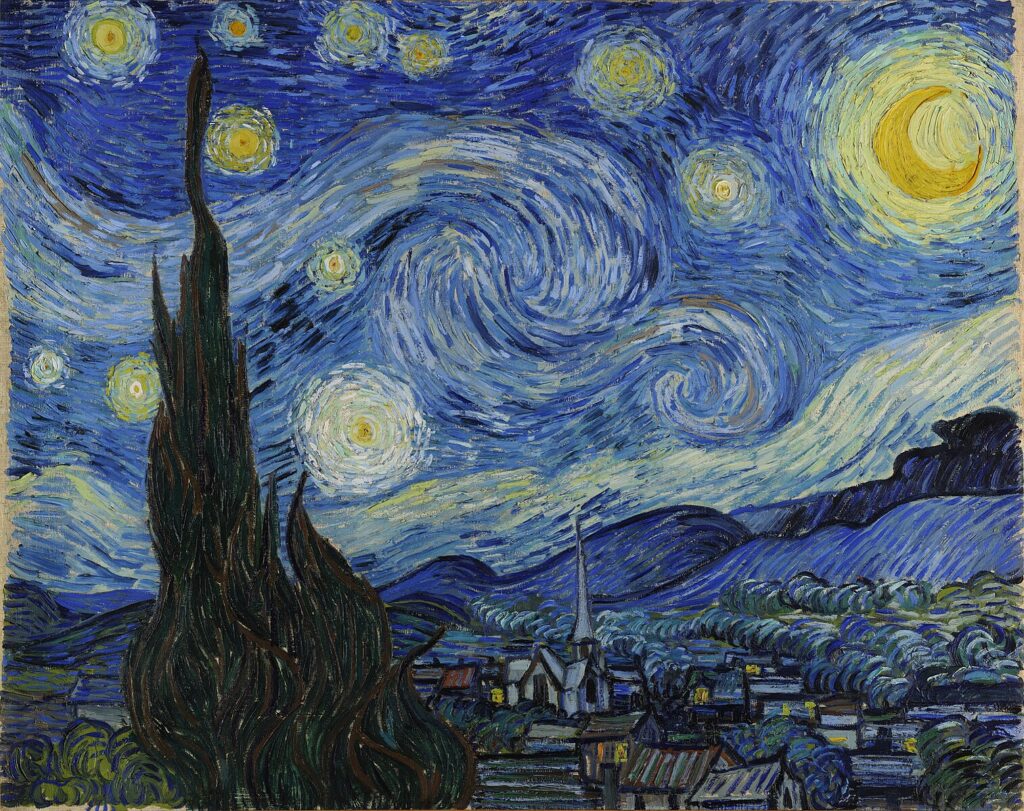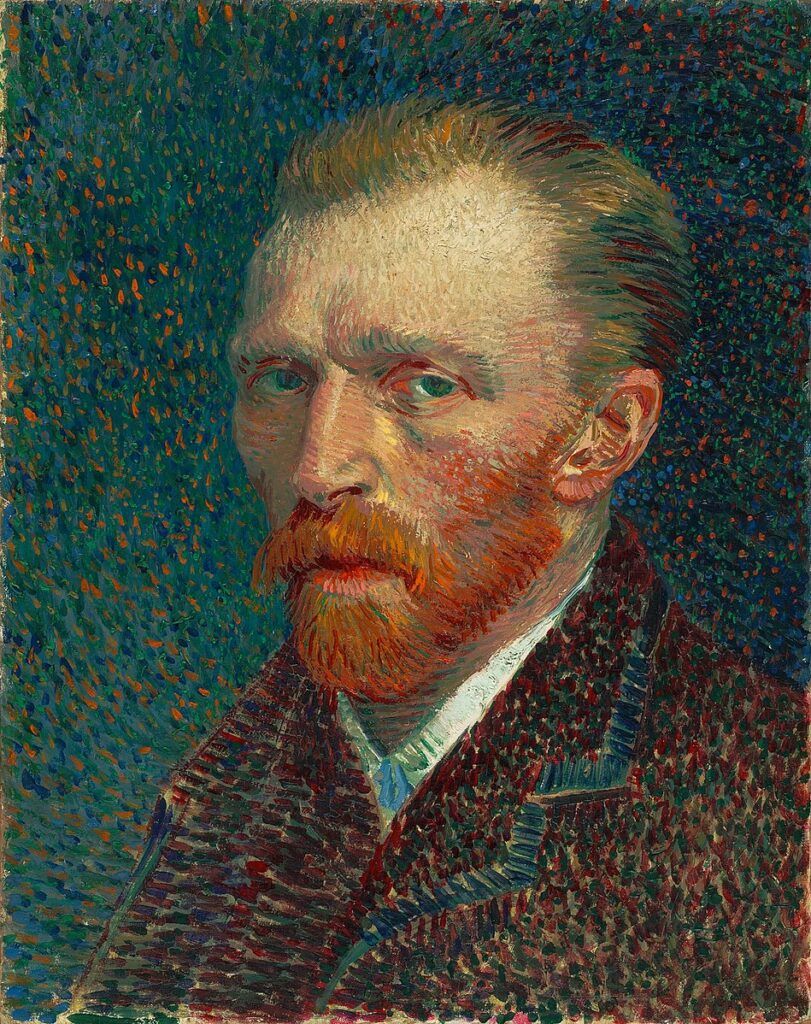When people are asked about famous paintings, chances are they will say Leonardo Da Vinci’s Mona Lisa and The Last Supper, Edvard Munch’s The Scream, and Vincent van Gogh’s The Starry Night.
The Starry Night, a beautiful yet gloomy oil-on-canvas painting, is usually in the top three or five of the most popular paintings list. It’s for good reason too since the artwork is not only beautiful—it also has an incredible story.

Who Was Vincent van Gogh?
Vincent van Gogh is one of the most famous and influential painters of all time. He was a Dutch post-impressionist artist known for his distinctive and highly expressive artwork.
Van Gogh is renowned as the genius behind more than 2,100 works of art. This includes 860 oil paintings that were mostly made during the last two years of his life between 1898 and 1890.
The artist was born into an upper-middle-class family, which should have given him a leg up in life. However, van Gogh suffered from mental illness that was evident even during his young life.
In 1888, van Gogh wanted to inspire change in his art. He wanted to create something other than the impressionist paintings he was used to. So, he moved to Arles, France with the goal of starting an artistic commune.
While in Arles, there was an apparent change in van Gogh’s paintings. They were brighter and were obviously inspired by the nature that surrounded him.
His peer, Paul Gauguin, joined him in Arles that same year. However, one night, the two friends had an argument that ended with van Gogh cutting his ear off with a razor.
Prior to that, van Gogh admitted to suffering from delusions and psychotic episodes. He also drank heavily and wasn’t eating well.
In the months that followed his self-mutilation, van Gogh voluntarily admitted himself to the Saint-Paul-de-Mausole Lunatic Asylum in Saint-Rémy-de-Provence in 1989.
What does this have to do with The Starry Night? It was at the asylum where van Gogh painted his most famous work.

A Breakout of Genius at the Asylum
He may have lost his mind but he never lost his creativity.
It was a stroke of luck that the facility, which mostly catered to upper-class families, was not packed. Van Gogh occupied two rooms at the asylum—a second-floor bedroom and a ground-floor room that he used as a studio.
Van Gogh painted about 150 artworks at the asylum during his stay from 1889 to 1890. The following are some of van Gogh’s works while confined:
- Almond Blossom
- Irises
- Self-Portrait with Bandaged Ear
- Self-Portrait with Bandaged Ear and Pipe
- The Courtyard of the Hospital at Arles
- The Thresher
- Ward in the Hospital at Arles
Many believed that his magnum opus was made in June 1889 because of a letter he sent to Theo, his brother.
It read in part, “At last I have a landscape with olive trees and also a new study of a starry sky. Though I have not seen either Gauguin’s or (Emile) Bernard’s last canvases, I am pretty well convinced that these two studies I’ve spoken of are parallel in feeling.”
The Starry Night wasn’t the only painting that was inspired by van Gogh’s view from his second-floor bedroom. Accounts have stated that 21 other similar paintings were found.
A month before “The Starry Night” was made, van Gogh wrote to Theo. He wrote, “Through the iron-barred window, I can see an enclosed square of wheat… above which, in the morning, I watch the sun rise in all its glory.”
Why Was The Starry Night Considered Beautiful?
The oil-on-canvas painting is described as a night sky depicted by blue and white swirling patterns dotted by yellow stars and dominated by a crescent moon. Underneath the sky is a village with a towering flame-like structure that is said to depict cypress trees.
For many, the painting is striking because of its use of contrasting colors as well as the visible strokes and swirls on the canvas. It is attractive and poignant.
It becomes even more beautiful when you know the words that van Gogh used to describe what he was seeing from his window.
In yet another letter to his younger brother, van Gogh stated, “This morning I saw the countryside from my window a long time before sunrise with nothing but the morning star, which looked very big.”
Incidentally, researchers say that Venus, also known as the morning star, was visible in Saint-Rémy-de-Provence in the spring of 1889.
Some also consider The Starry Night beautiful simply because of its story and the genius behind it. The painting has been the subject of many analyses, studies, and interpretations. Some even established a link between the painting and van Gogh’s mental illness.
There was an investigation by scientists from the Rochester Institute of Technology and a collaboration with the Museum of Modern Art in New York. They learned that the artist employed ultramarine and cobalt blue colors to depict the night sky as well as Indian yellow and zinc yellow for the stars and the moon.
Where Is The Starry Night Painting Now?
Van Gogh always sent his paintings to Theo but he held on to The Starry Night longer than most. Finally, in September 1889, van Gogh sent The Starry Night and a few others to Theo.
Less than a year later, van Gogh shot himself in the chest while painting in a field. He survived the shooting but only lived for a few days more as he died from an infected wound.
Theo worked hard to elevate van Gogh’s status as an artist in Europe. In the last few years of van Gogh’s life, the artist gained renown among artists and art enthusiasts in France.
However, Theo’s efforts were cut short when Theo died six months after van Gogh’s death.
Theo’s widow, Johanna Gezina van Gogh-Bonger, took custody of van Gogh’s paintings. In 1900, van Gogh-Bonger sold the painting to Julien Leclercq, a 19th-century French poet and art critic.
A year later, Leclerq sold The Starry Night to Gauguin’s friend, impressionist painter and art collector Claude-Emile Schuffenecker.
Van Gogh-Bonger bought the painting back but sold it again in 1906 to the Oldenzeel Gallery in Rotterdam. The painting found its way to Georgette P. van Stolk who kept it from 1906 to 1938.
It was later sold to art collector Paul Rosenberg. Finally, in 1941, the Museum of Modern Art acquired The Starry Night which is where it can be found to this day.
Despite van Gogh’s troubled mental state and his turbulent life (or perhaps because of it), The Starry Night remains the most famous painting at MOMA.

